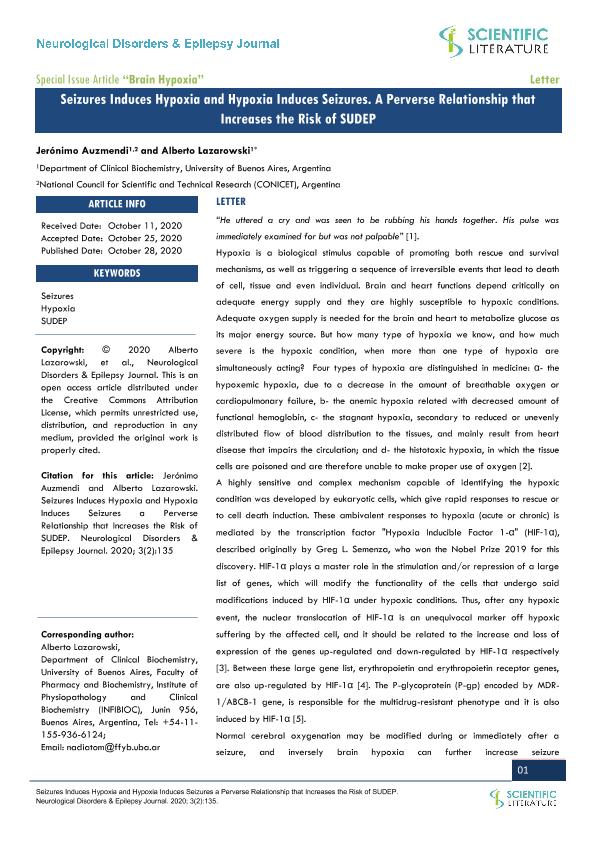Mostrar el registro sencillo del ítem
dc.contributor.author
Auzmendi, Jerónimo Andrés

dc.contributor.author
Lazarowski, Alberto Jorge

dc.date.available
2021-06-25T12:02:53Z
dc.date.issued
2020-10
dc.identifier.citation
Auzmendi, Jerónimo Andrés; Lazarowski, Alberto Jorge; Seizures Induces Hypoxia and Hypoxia Induces Seizures: A Perverse Relationship that Increases the Risk of SUDEP; Scientific Literature; Neurological Disorders & Epilepsy Journal; 10-2020; 1-6
dc.identifier.issn
2349-5014
dc.identifier.uri
http://hdl.handle.net/11336/134927
dc.description.abstract
He uttered a cry and was seen to be rubbing his hands together. His pulse wasimmediately examined for but was not palpable.Hypoxia is a biological stimulus capable of promoting both rescue and survivalmechanisms, as well as triggering a sequence of irreversible events that lead to deathof cell, tissue and even individual. Brain and heart functions depend critically onadequate energy supply and they are highly susceptible to hypoxic conditions.Adequate oxygen supply is needed for the brain and heart to metabolize glucose asits major energy source. But how many type of hypoxia we know, and how muchsevere is the hypoxic condition, when more than one type of hypoxia aresimultaneously acting. Four types of hypoxia are distinguished in medicine: α- thehypoxemic hypoxia, due to a decrease in the amount of breathable oxygen orcardiopulmonary failure, b- the anemic hypoxia related with decreased amount offunctional hemoglobin, c- the stagnant hypoxia, secondary to reduced or unevenlydistributed flow of blood distribution to the tissues, and mainly result from heartdisease that impairs the circulation; and d- the histotoxic hypoxia, in which the tissuecells are poisoned and are therefore unable to make proper use of oxygen.
dc.format
application/pdf
dc.language.iso
eng
dc.publisher
Scientific Literature
dc.rights
info:eu-repo/semantics/openAccess
dc.rights.uri
https://creativecommons.org/licenses/by-nc-sa/2.5/ar/
dc.subject
SEIZURES
dc.subject
HYPOXIA
dc.subject
SUDEP
dc.subject.classification
Neurociencias

dc.subject.classification
Medicina Básica

dc.subject.classification
CIENCIAS MÉDICAS Y DE LA SALUD

dc.title
Seizures Induces Hypoxia and Hypoxia Induces Seizures: A Perverse Relationship that Increases the Risk of SUDEP
dc.type
info:eu-repo/semantics/article
dc.type
info:ar-repo/semantics/artículo
dc.type
info:eu-repo/semantics/publishedVersion
dc.date.updated
2021-03-15T15:47:36Z
dc.journal.pagination
1-6
dc.journal.pais
Estados Unidos

dc.journal.ciudad
Wilmington
dc.description.fil
Fil: Auzmendi, Jerónimo Andrés. Universidad de Buenos Aires. Facultad de Farmacia y Bioquímica. Departamento de Bioquímica Clínica; Argentina. Consejo Nacional de Investigaciones Científicas y Técnicas. Oficina de Coordinación Administrativa Houssay; Argentina
dc.description.fil
Fil: Lazarowski, Alberto Jorge. Universidad de Buenos Aires. Facultad de Farmacia y Bioquímica. Departamento de Bioquímica Clínica; Argentina
dc.journal.title
Neurological Disorders & Epilepsy Journal
dc.relation.alternativeid
info:eu-repo/semantics/altIdentifier/url/https://scientificliterature.org/Neurologicaldisorders/Neurologicaldisorders-20-135.pdf
Archivos asociados
